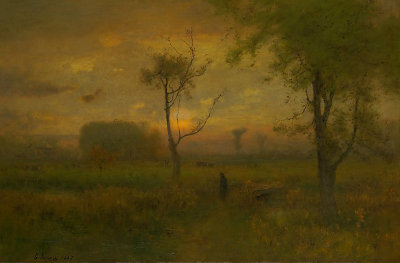Search:: Artists Alphabetically Artists by Country Artists by Century Artists by Movement
George Inness
"The Father of American Landscape Painting"
1825-1894
American Tonalist Landscape Painter
Education - Primarily Self-taught
Physical Health - He suffered from epilepsy since childhood.
Cause of Death - Heart Attack, he died in Scotland

Artist Bio
George Inness received no formal education in art but traveled many times to Europe. While in France, Italy and England he met many influential painters and gleaned a wealth of knowledge which influenced the style of his work. According to his biographer, Mary Schell Hoke Bacon, "He was forty years old before he got to Paris, but once there, he turned to the men at Barbizon--Rousseau, Millet, Corot, and the rest--for inspiration, and began to do beautiful things indeed. Rousseau became his friend, and the art of Inness grew large and rich through such influences."
He is best known for his later works, landscapes influenced by the ideas of Swedish philosopher Emanuel Swedenborg. The philosopher wrote that "For the spiritual sense of the Word treats everywhere of the spiritual world, that is, of the state of the church in the heavens, as well as in the earth; hence the Word is spiritual and Divine."
George Inness's landscape paintings changed from his more realistic Hudson River period to a luscious and luminous style with evocative atmospheric effects featuring misty backgrounds illuminated by moonlight. Inness asserted "The purpose of the painter is simply to reproduce in other minds the impression which a scene has made upon him. A work of art does not appeal to the intellect. It does not appeal to the moral sense. Its aim is to instruct, not to edify, but to awaken an emotion."
Description of the Tonalist Painting Style and TechniqueTonalism is rooted in the French Barbizon movement, which emphasized atmosphere and shadow. The Tonalist style employs a distinctive technique by the use of color's middle values as opposed to stronger contrast and high chroma. Resulting in a understated and compelling overall effect. The tonalist subject matter is never entirely apparent; their is no effort to communicate a message or narrate a story. Instead of relating a story, each sensitively chosen color, composition, and line is arranged to create an intriguing visual poem.
The interiors of tonalist paintings are generally elegant and sparsely decorated, tonally uniform, simplified and indistinct; the figures are usually presented alone in silent contemplation. Landscapes are typically luscious and luminous with evocative atmospheric effects featuring misty backgrounds illuminated by moonlight. Tonalists painters were drawn to both the natural and spiritual realms. They sought to awaken the viewers consciousness by shrouding the subject in a misty indistinct veil of emotionalism. The palette is minimal, characterized by warm hues of brown, soft greens, gauzy yellows and muted grays. Preferred themes were evocative moonlight nights and poetic, vaporous landscapes. Tonalist painters seemed to favored unconscious states and psychological experiences over reality.
Principle Painters of Tonalism Movement
Ralph
Albert Blakelock American,
1847-1919
Thomas
Wilmer Dewing American,
1851-1938]
Robert
Swain Gifford American,
1840-1905
Alexander
Thomas Harrison American,
1854 -1929
Lowell
Birge Harrison American,
1854-1929
George
Inness American,
1825-1894
John
La Farge American,
1835-1910
Arthur
Frank Mathews American,
1860-1945
John
Francis Murphy American,
1853-1921
Albert
Pinkham Ryder American,
1847-1917
John
Henry Twachtman American,1853-1902
Julian
Alden Weir American,1852-1919
James
Abbott McNeill Whistler American,
1843-1903
Important words and phrases associated with the Tonalist movement - obscured details, single-figure themes, the natural and spiritual domain, waking, unconscious states, sleep, dreams, death, aura, religious significance, emotionalism, emotionalists, pictorial space, compositional space, diffused light, incandescent glow, organic forms, artistic inspiration, illusionistic representation, luminous, transcendentalist, glowing, metaphysical, emotional expression, poetic, evocative
Require more facts and information about Tonalist Artists? Poke around every nook and cranny of the known universe for information this subject. Search Here
If
you feel you have worthwhile information you would like to contribute
we would love to hear from you. We collect essential biographical
information and artist quotes from folks all over the globe and
appreciate your participation. When submitting please, if possible,
site the source and provide English translation. Please
submit your comment to the editor, via e-mail and if possible site the
source. Thank you!
© HistoryofPainters.com
If you like this page and wish to share it, you
are welcome to link to it, with our thanks.
copyright 2017 - historyofpainters.com